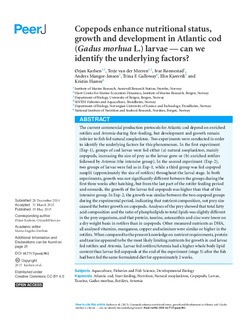| dc.description.abstract | The current commercial production protocols for Atlantic cod depend on enriched rotifers and Artemia during first-feeding, but development and growth remain inferior to fish fed natural zooplankton. Two experiments were conducted in order to identify the underlying factors for this phenomenon. In the first experiment (Exp-1), groups of cod larvae were fed either (a) natural zooplankton, mainly copepods, increasing the size of prey as the larvae grew or (b) enriched rotifers followed by Artemia (the intensive group). In the second experiment (Exp-2), two groups of larvae were fed as in Exp-1, while a third group was fed copepod nauplii (approximately the size of rotifers) throughout the larval stage. In both experiments, growth was not significantly different between the groups during the first three weeks after hatching, but from the last part of the rotifer feeding period and onwards, the growth of the larvae fed copepods was higher than that of the intensive group. In Exp-2, the growth was similar between the two copepod groups during the experimental period, indicating that nutrient composition, not prey size caused the better growth on copepods. Analyses of the prey showed that total fatty acid composition and the ratio of phospholipids to total lipids was slightly different in the prey organisms, and that protein, taurine, astaxanthin and zinc were lower on a dry weight basis in rotifers than in copepods. Other measured nutrients as DHA, all analysed vitamins, manganese, copper and selenium were similar or higher in the rotifers. When compared to the present knowledge on nutrient requirements, protein and taurine appeared to be the most likely limiting nutrients for growth in cod larvae fed rotifers and Artemia. Larvae fed rotifers/Artemia had a higher whole body lipid content than larvae fed copepods at the end of the experiment (stage 5) after the fish had been fed the same formulated diet for approximately 2 weeks. | nb_NO |
